| ‘ J-PARC News - December 2016 (Issue #140) |
| World's First Successful Practical Application of a Technique for High-Precision Determination of the Diffraction Spot Intensity in Protein Single Crystals Using Pulsed Neutrons- Achieved Using the IBARAKI Biological Crystal Diffractometer (iBIX) - (December 16, Press Release) |
|---|
| Research Associate Naomine Yano and others from the Frontier Research Center for Applied Atomic Sciences, Ibaraki University, together with a group from the J-PARC Center, have successfully achieved practical application of a profile fitting method for determining diffraction spot intensity at high-precision in pulsed neutron diffraction of protein single crystals. This technique is implemented in the diffraction data processing software STARGazer and can be easily used by users. Therefore, it is expected to contribute to R&D in fields such as energy problems and drug development. This result was established in an experiment using the IBARAKI Biological Crystal Diffractometer (iBIX), and was featured on December 1 in the open-access journal Scientific Reports, a sister journal of the British science journal Nature. |
|
| Held 1st Neutron and Muon School (November 22-26, Ibaraki Quantum Beam Research Center, MLF) |
|---|
| From November 22 to 26, the J-PARC Center held the 1st Neutron and Muon School using MLF beamlines. The school was held jointly with the Japanese Society for Neutron Science, the Society of Muon and Meson Science of Japan, JAEA, KEK, the Comprehensive Research Organization for Science and Society (CROSS), and other organizations. This school was held for graduate students, young researchers, and similar candidates from the Asia/Oceania region, and is the successor of the MLF School held three times until last year. There were 29 participants, the majority of whom (16) were from overseas. Professor Yoshiaki Kiyanagi (Nagoya University), Chairman of the Japanese Society for Neutron Science, acted as director of the school, and university professors involved with the MLF and other relevant people were invited as lecturers. Between lectures, there were tours of J-PARC's experimental facilities, and the neutron beam hall of Japan Research Reactor JRR-3. In addition, in training using neutron and muon beams, the students were divided into nine training groups by desired instrument. Then they conducted practical experiments using beams and analyzed data, under the guidance of persons in charge of each instrument. On the final day, results were reported through presentations by each team. Dr. Kanaya, Head of the Materials and Life Science Division conducted a science seminar, and at the end each participant was given a certificate of school completion by Prof. Kiyanagi. School participants said that the experience was "very educational." |
| |
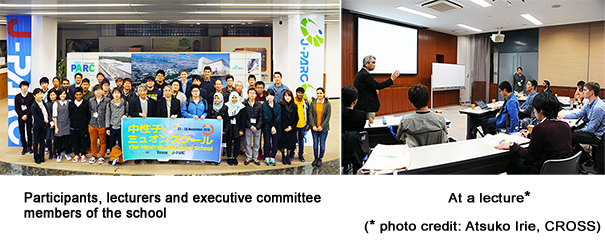
 * Click here to enlarge. * Click here to enlarge. |
| |
| £to Page Top |
| |
|
| Conducted J-PARC Safety Audit (November 22, J-PARC) |
|---|
| On November 22, two outside audit committee members (specialization: safety / human factors engineering, radiation science and engineering) were invited, and the J-PARC safety audit for fiscal 2016 was carried out. The Director, Deputy Directors, Head of the Safety Division, managers of each facility, and other involved staff were interviewed primarily about the conduct of safety management over the year, and there was an on-site inspection of the Hadron South Experiment Building completed in March of last year. In the auditors' comments, a high evaluation was given to the fact that autonomous safety management/activities are functioning effectively at each facility. Furthermore, the committee members provided valuable observations and proposals, such as gathering information on worries from workers and users regarding each type of work, and the effectiveness of risk assessment using a reversed thought process of considering what to do in order to cause an accident. |
| |
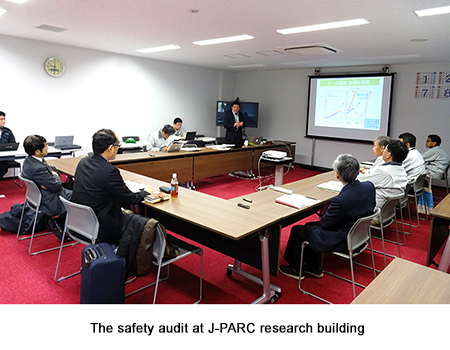
 * Click here to enlarge. * Click here to enlarge. |
| |
| £to Page Top |
| |
|
| Held 3rd Meeting of TEF Technical Advisory Committee (T-TAC) (December 12-14, J-PARC) |
|---|
| From December 12 to 14, the J-PARC Center held the third meeting of the Transmutation Experimental Facility (TEF) Technical Advisory Committee (T-TAC) with invited experts from inside and outside Japan to review design and R&D for construction of the TEF at J-PARC. First, the committee members observed the experimental apparatuses for developing elemental technologies needed for the TEF construction. At the subsequent committee meeting, Naohito Saito, Director of the J-PARC Center, and others explained the mission and charge of T-TAC, and provided an overview of J-PARC and the TEF program. After that, there were about 20 reports by the TEF development team and a lively exchange of questions and answers on topics such as detailed design of the facility, the development status for elemental technologies, and safety design. At the end, the committee chair, Dr. Marc Schyns of the Belgium Nuclear Research Centre (SCK₯CEN), gave us many recommendations including remaining issues which need to be examined in the future in the lead-up to construction of the TEF. |
| |
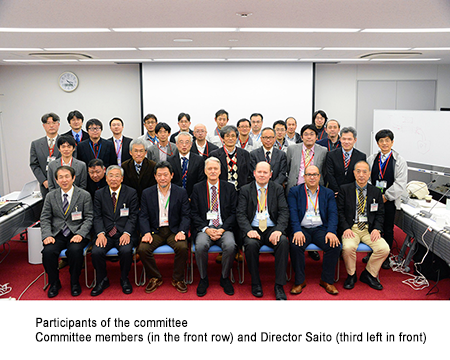
 * Click here to enlarge. * Click here to enlarge. |
| |
| £to Page Top |
| |
|
| Received Technology Award at 14th Japanese Society of Neutron Science Awards (December 1-2, Nagoya University) |
|---|
| At the 16th annual meeting of the Japanese Society for Neutron Science, the group which constructed the Biomolecular Dynamics Spectrometer (DNA) at the J-PARC Center received the Technology Award in the 14th Japanese Society of Neutron Science Awards. This was in recognition of the achievement having contributed to practical application of the Biomolecular Dynamics Spectrometer (DNA) of MLF neutron beamline BL02. The awards ceremony was held on the first day of the society's 16th annual meeting, held at Nagoya University on December 1 and 2. Acting as representative of the group, Dr. Kaoru Shibata of the J-PARC Center's Neutron Science Section received the award certificate and supplementary prize from Chairman Yoshiaki Kiyanagi. The DNA is an instrument suitable for measuring detailed atomic, molecular, and spin motion states in the nanosecond region. It was constructed to elucidate motion mechanisms (dynamics) of atoms, molecules, spin and other factors in a wide range of research fields such as biological materials, soft matter, functional materials, and magnetic materials. |
| |
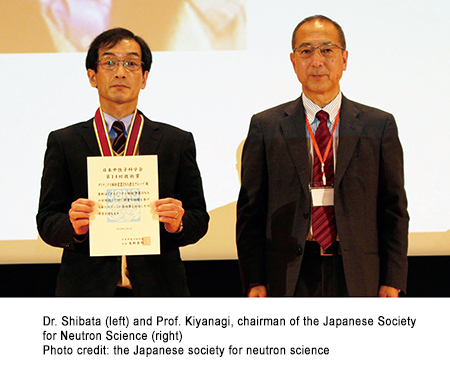
 * Click here to enlarge. * Click here to enlarge. |
| |
| £to Page Top |
| |
|
| Held International Workshop on Future Potential of High-Intensity Proton Accelerator for Particle Nuclear Physics: HINT2016 (December 5-8, Ibaraki Quantum Beam Research Center) |
|---|
| The international workshop "HINT2016" was held for four days, from December 5 to 8, and brought together 146 participants. This event has been held at J-PARC since last year, and there were various reports and discussions focusing on the future outlook for high-intensity accelerator facilities, and new physics pioneered using high-intensity beams. HINT2016 was held jointly with the KEK Flavor Factory (KEK-FF) Workshop, and the content broadly covered "flavor physics" including B mesons, tau particles, and related topics. Invited speakers included not only researchers involved with J-PARC and the SuperKEKB project, but also researchers from major projects overseas. Researchers sharing the aspiration to explore new physics-both theoreticians and experimentalists-met in the same hall, where they exchanged information and engaged in discussions to develop research going forward. |
| |
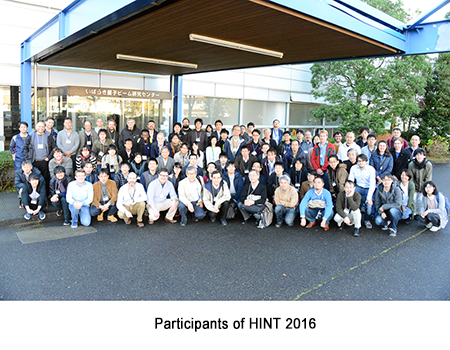
 * Click here to enlarge. * Click here to enlarge. |
| |
| £to Page Top |
| |
|
| Held Research Meeting "Towards High-Precision Muon g-2/EDM Measurement at J-PARC" (November 28-29, J-PARC) |
|---|
| At the H line of the Muon Experimental Facility of the MLF at J-PARC, a project is underway to precisely measure the strength of the magnetic force of the muon called the "anomalous magnetic moment (g-2)" using a completely new, previously unavailable experimental technique. To realize this plan, the J-PARC Center jointly held a research meeting, together with the Joint Institute for Computational Fundamental Science (JICFuS), to realize improved precision of g-2 calculations and experiments. At the meeting, there were 54 participants from 12 countries of the world (including 23 from overseas), and there were lively discussions of new theoretical techniques and experimental technologies. After the meeting finished, there was a tour of facilities, and some participants commented on their expectations for realization of the plan at J-PARC. |
| Muons are one type of elementary particle, and they have properties as small magnets accompanying their own rotation. The strength of that magnetic force (g-2) can actually be calculated to a precision of 7 digits using the standard model of elementary particles. However, as a result of previous experiments conducted at Brookhaven National Laboratory in the U.S., a slight discrepancy is evident between experimental values and this theoretical value, and that is attracting attention for perhaps indicating a slight unraveling of the standard model. Therefore, there are high expectations on independent verification using the H line of the Muon Experimental Facility. |
| |
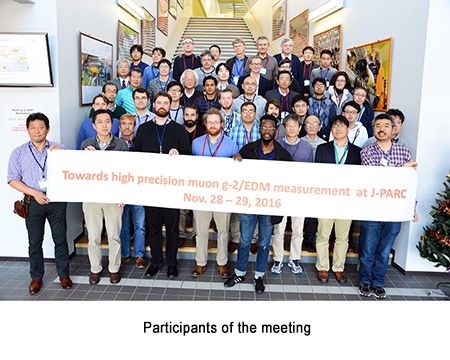 |
| |
| £to Page Top |
| |
|
| Held J-PARC Hello Science Event "From 'atoms' to 'super strings' - The Scientists Fascinated by Elementary Particles" (December 5, Aeon Tokai) |
|---|
| Starting this month, the J-PARC Center has begun holding "J-PARC Hello Science" events to promote interaction between researchers and local people, using as a venue the food court of the Aeon Tokai Mall in front of JR Tokai Station. The first event was held on December 5, and J-PARC public relations advisor, Shinichi Sakamoto, took up the topic of the "elementary particles" which make up the universe. He spoke on their ultimate nature, while tracing the history of struggles by the many scientists who have tried to investigate micro particles. From January of next year, the program will also receive support from Tokai Village, and the plan is hold events primarily at Aeon Tokai, while changing the topic each time. The schedule, content, and other information will be announced via posters and other media. Participation is free, so why not drop in? |
| |
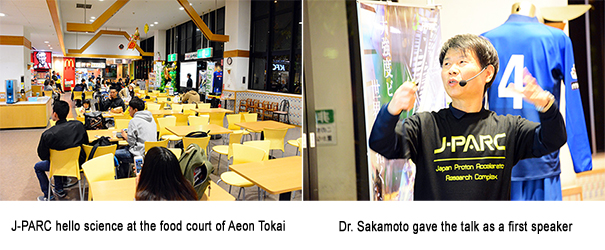 |
| |
| £to Page Top |
| |
|
©2017 J-PARC Center. All rights reserved.
|
|